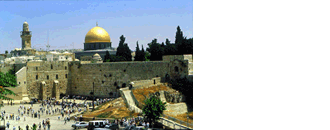
|
|
|
|
|
Class Prep
|
|
|
|
What Is "the Bible"? When & Why Was It Written?

- Today's class is about the nature and composition of the Bible. It provides an overview or framework that will introduce you to the academic study of scripture and to the complex histories behind each of its books. If you have some familiarity with the Bible, chances are that a lot of this information will be new, since the Bible functions very differently in our culture today than it did when its books were composed, or in subsequent Jewish and Christian tradition (such as the end-piece from a handwritten medieval manuscript of the Jewish Bible to the right).
-
- Before you begin reading, spend about 10 minutes writing a journal entry on the reflection question for today: What is your mythology, and what has shaped it? Notice here that "mythology" is not being defined as you might think; in this context, it doesn't mean "fiction" or "false story." Rather, mythology is the stories we tell about our families, our selves, the groups we belong to and our world—stories that shape our identity and direct our choices. College is a time in your life when you find yourself in a variety of new situations, consciously (and sometimes unconsciously) choosing what to reveal about yourself to others, selecting and adapting what is most important in your own worldview. So what stories have shaped you the most? What resources do you draw on to understand yourself, your choices, your world?
-
- As for our reading, we'll be starting Kristin Swenson's book today. Trained in the study of the Hebrew Bible/Tanak/Old Testament, Swenson also studied under Stephen Prothero, a scholar at Boston University whose research is about religion in popular culture in the U.S. today (some of his books are listed below). She's perfectly suited to provide background to the Bible that is both historically informed and currently relevant.
As you read her introduction to the Bible, develop responses to the following questions:
- What does the word "Bible" mean, and what does that mean for how one might read it?
- What forms did the Jewish scriptures take in antiquity, and what are the current three sections of the Jewish Bible? Be able to describe each of the sections.
- Compare the Tanakh to the Christian Old Testament, and the Protestant Bible to the Catholic Bible.
- In the chapters you're reading for today, Swenson discusses the history in the text (the stories told in the Bible, ch. 3) and the history of the Bible (how the Bibles we read came to be, ch. 5). From chapter 3, become familiar with the general storyline of the Bible. From chapter 5, be able to discuss the documentary hypothesis for the composition of Torah.
-
- Also, be able to define the following terms:
- annotated Bible
- cross-reference
- Septuagint
- Tanakh
- Documentary Hypothesis
-
-
- Assigned Readings
-
- Secondary: Swenson, Bible Babel 1-30, 42-52
-
-
- Slides from Lecture
-
-
- Religious Studies courses about this topic
- RTC 2
- The Bible as Literature (ENGL 161)
- Science vs. the Bible: The Genesis Debates (SCTR 35)
- Religious Imagination (TESP 53)
- Spirituality and Literature (TESP 55)
-
- RTC 3
- Media and Religion (RSOC 119)
- Representing Religion in World Cinema (RSOC 121)
- Religions in the Making of American Identities (RSOC 176)
- Biblical Poetry and Ancient Myth (SCTR 100)
- Gods, Heroes, and Monsters: Myth and Bible (SCTR 110)
- Belief and Unbelief (TESP 125)
- Telling Your Story: Discerning Vocation (TESP 132)
- Religious Autobiography (TESP 147)
- Catholic Themes in Literature (TESP 153)
- Finding Your Own Spirituality (TESP 176)
-
- Further Reading
-
- Setzer, Claudia and David A. Shefferman, eds. The Bible and American Culture: A Sourcebook. New York: Routledge, 2011.
-
- Prothero, Stephen R. American Jesus: How the Son of God became a National Icon. New York: Farrar, Straus, and Giroux, 2003.
-
- --------. God Is Not One: The Eight Rival Religions that Run the World—And Why Their Differences Matter. New York: HarperOne, 2010.
-
- --------. A Nation of Religions: The Politics of Pluralism in Multireligious America. Chapel Hill: University of North Carolina Press, 2006.
-
- --------. Religious Literacy: What Every American Needs to Know—and Doesn't. New York: Harper One, 2008.
-
-
- Links
- Kristin Swenson - Personal web page of the author of our text, Bible Babel, including background on her research and a blog about the book we're reading.
-
-
- Sources
- Photographs:
-
-
|
|
|
|
|
